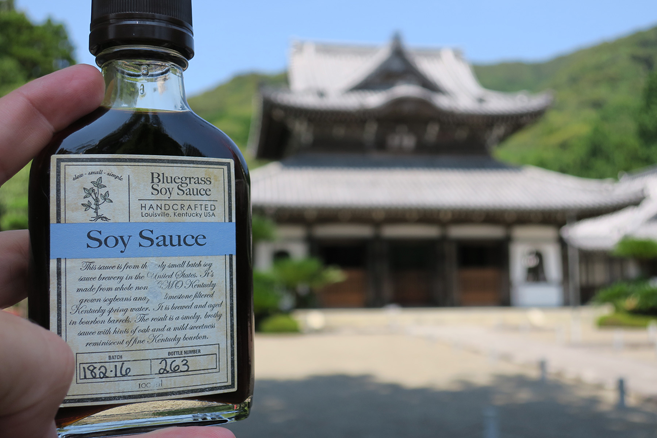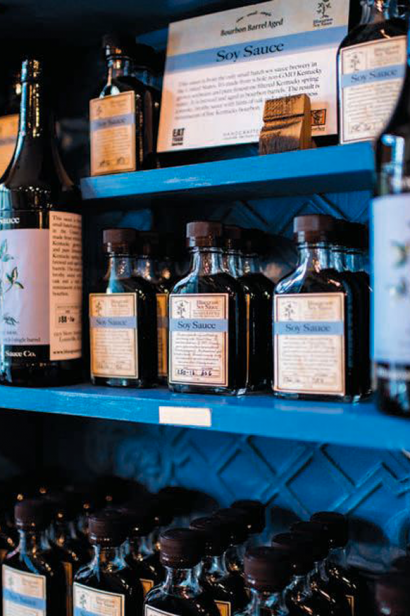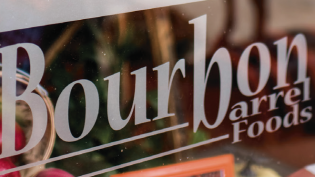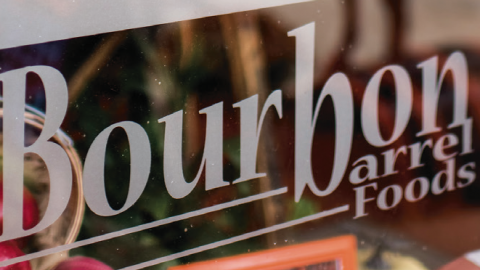Seasonings Greetings
When Matt Jamie founded Bourbon Barrel Foods (BBF) in 2006, he says some called it crazy that a “six-foot-tall blonde gaijin” (foreigner) who had never set foot in Japan would create a soy sauce brand, that the production of this iconic Asian staple was better done there.
Turns out none of Jamie’s detractors asked the Japanese if they held those same assumptions. Now, 10 years later, Japanese soy sauce manufacturers and distributors are bringing BBF’s Bluegrass Soy Sauce to the Land of the Rising Sun in what seems like the ultimate “selling ice to Eskimos” transaction. According to Jamie’s Japanese contemporaries, an American-made, small-batch soy sauce created using traditional Japanese methods will sell in their market because of its uniqueness and high quality.
“People here challenged me by saying I couldn’t make soy sauce because I’d never been in Japan,” Jamie says. “But the Japanese producers I’ve met told me it was a good thing I never trained there because I’d be making what they already have. And that’s not interesting.”
True, Jamie hadn’t actually been to Japan until this past February. Nine months into 2016, he’s visited four times, having traveled there initially as a guest on an episode of “Sugoi Desu Ne Shisatsudan,” a Food Network/History Channel-esque show that focused on the making of Bluegrass Soy Sauce. Return trips have been all about building business contacts and studying methods of other soy sauce makers.
While there in February he met Toshio Shinko, the soy sauce brewer behind the Yuasa brand, which is regarded by some as the world’s best. Flattered Shinko would even invite him to his factory, the two men struck up so tight a friendship that Shinko visited Jamie in Louisville this summer and toured his Louisville plant.
“Here’s me talking to him about our process and our ingredients, and he’s listening,” says a still-humbled Jamie. Turns out Shinko was elated to connect with someone who understood his intricate trade. “He’s like me: thinks it’s exciting stuff , but knows it’s tough to get other people excited about it.”
Jamie-san goes to Japan — four times
In February, Jamie was asked by a Japanese TV show, “Sugoi Desu Ne” (roughly translated as “awesome producer”), to make a guest appearance and talk about BBF’s soy sauce. Eager to make a pilgrimage to the land where the best soy sauce is made, Jamie fl ew to Tokyo just two weeks later.
“What was funny was this talent agency said they’d had a hard time finding me,” he begins, “when all they had to do was Google ‘blond-haired soy sauce maker’ and I’d have popped right up.”
And in Japan, the bespectacled six-foot blond stuck out among the shorter natives until he made friends with a six-foot-five German man staying at the same hotel.
“He took all the attention off of me,” Jamie laughs. “He owned a dim sum company in Germany. We hung out that night. Nice guy.”
Though the show’s recording went well, and while Jamie enjoyed the “rock star treatment,” he calls it unfamiliar territory. He soon understood that the kindness extended him was a blend of respect for his work and the unending manners of the Japanese.
“The culture is just so different there, the patience they have, the order of things, their neatness, the respect they show people— and not just me,” he says. “One day as I went through the train station, I saw this mass of people moving in a single direction—and so quiet, no one on a cell phone, just total focus of going onto the train and all at the same pace.”
Part of the “Sugoi Desu Ne” episode featured Jamie meeting Shinko and touring his soy sauce brewery. The men met, and Jamie learned that Shinko had been studying BBF, watching soy sauce making videos on You Tube to understand BBF techniques. An immediate collaboration between the peers took shape, which included Shinko respectfully criticizing Jamie’s use of a drill-driven agitator to stir the fermenting soy mash “because it was too violent,” says Jamie, adding that he agreed. Yet when Shinko disagreed with BBF using calcium- rich “hard water” in the brew, Jamie explained that Kentucky’s limestone-filtered water “is a part of our terroir, part of our story. It’s what we have available to us, and I believe it gives body to the soy sauce. [Shinko] said he understood that.”
What Jamie regards as a brilliant lesson was Shinko’s suggestion to reuse all water spent on cooking the soybeans.
“He asked what I did with it, and when I told him I threw it out, he said, ‘No, no, no, no, no! Save that water because there’s flavor in it,’” Jamie recalls. “I immediately texted the office and said to change that part of our process, and now we make our brine with that water.”
When Shinko suggested Jamie return just weeks later in March to attend Foodex Japan, Asia’s largest food and beverage trade show, he booked his flight. There, Shinko introduced Jamie to numerous distributors who could help get BBF’s products into the Japanese market, as well as food writers who could generate pre-sale publicity.
When Jamie returned to the U.S., he met with a food export advisor he’d been working with and told him that doors were opening in Japan for BBF. The man was amazed, and said his services were no longer needed.
Jamie recalls: “The advisor began, ‘You couldn’t have written that any better. You were on national television in the country where you’re trying to export to … that’s gold!’”
Jamie allows that exporting BBF products was part of his dream for the company, but not a near-term expectation. Now that he’s in the thick of preparing for a Japanese market launch, he finds himself on a 90° learning curve every day.
“But that’s also the fun part of being an entrepreneur: Figuring things out keeps it interesting,” he says. “Working to get into Japan presents the language barrier, of course, and a 13-hour time difference. Even emails for a simple question take a day and a half to answer.”
And it’s not just Bluegrass Soy Sauce that Japanese distributors want. They’ve asked Jamie for the bulk of the BBF line of smoked salts, sugars and spices, Worcestershire and barbecue sauces and more.
“When we started the discussion to get there, I didn’t want to cloud the conversation by talking about the whole line, so I left it at soy sauce,” he says. “But when they said they were interested in the complete line, it was, like, ‘Oh, no!’ But that’s great, of course. It’s awesome.”
Equally fun, he adds, was Shinko’s three-day visit to Louisville this summer, when the two worked in the BBF plant, and where Shinko made many suggestions on technique and cost savings.
“He saved me $15,000 by talking me out of buying a new [soy mash] press and instead using a special press cloth they use over there,” he says. “This cloth will last us 10 years, and all you do is throw it in the washing machine and reuse it.”
Jamie treated Shinko to a full-on Kentucky bourbon experience with a VIP tour of Woodford Reserve Distillery, and a visit to Cave Hill Cemetery to see the graves of Col. Sanders and Muhammad Ali. The whole BBF crew dined with Shinko at Proof on Main, and on another night, 610 Magnolia chef-owner Ed Lee cooked a special meal centered on Shinko’s soy sauces.
“Toshio was interested in seeing how Westerners use soy sauce, because it’s in a much different manner from how Japanese use it,” he begins. “In Japan, if you taste the soy sauce, it’s considered overpowering to the food. It’s like their salt, which should only make whatever you’re eating taste better. In the U.S., we love that forward taste of soy.”
As excited as Jamie is about his overseas prospects, his core business also is surging. Though expecting his BBF retail store in Crescent Hill would only break even in its fi rst year, its modest profit has him considering a Kentucky store in Lexington, and Tennessee stores in Nashville and Franklin. Demand for BBF products is also pushing local farmers for more soybeans, wheat and sorghum.
“I’m really proud that we have that direct farm impact,” he says. “Our sorghum grower started out growing 45 acres for us, and how he’s up to 100.”
Landing the contract this year as the Pendennis Club’s only licensed producer of Henry Baines sauce was also a coup. “From a business perspective, I didn’t need this [product], I really wanted this,” Jamie says. “It’s the original food story in Louisville, and it’s an easy and fun story to tell outside out Louisville.”
RECIPES








